Kanasana Mitake Castle
-Secure castle of struggle at sacred mountain-
Overview
Name: Kanasana Mitake Castle (Kanasana Mitake-jo)
Alias:
Place: Ninomiya Kamikawa town, Saitama
Location: 36.17867522977545, 139.06807862146306
Type: Mountain Castle
Built: 1480?
Remaining remnants: Stone walls, clay walls and dry moats
Title:
20 minutes drive from Kanetsu Jidoshado Expressway Honjo-Kodama interchange to parking of Kanasana Shrine. 30 minutes walk from parking to hilltop castle.
Type: Mountain Castle
Built: 1480?
Remaining remnants: Stone walls, clay walls and dry moats
Title:
Brief History
Kanasana Mitake castle (金鑚御岳城) is located over Mitake mountain, one of about 200 meter height from hillside at the northwest corner of current Saitama prefecture. Castle site is placed at the place where Kanna-gawa river, a tributary of Tone-gawa river, flows from Kanto-Santi mountain toward Kanto Plain.
Kanna-gawa river merges to the main stream of Tone-gawa river about 5 kilometer north of castle site, and two rivers form the northwest corner of Musashi province (Saitama prefecture). As the northward of castle site is a totally flat plain, this castle was only one fortress to protect northwest border of Musashi province.
Furthermore, the upstream of Kanna-gawa river is connected to inner part of Musashi province such as Chichibu area, or Saku area of Shinano province (Nagano prefecture) ahead of long mountain road. Movement of large army is difficult but preparing for sudden attack of small troop it was also necessary to prepare for upstream of Kanna-gawa river.
Mitake mountain and Kanasana Shrine
Mitake mountain was originally a object of worship for Kanasana Shrine. “Kanasuna” means iron sands, and upstream of Kanna-gawa river produced irons sand in ancient era then miners and blacksmiths worshipped the mountain under pretence to the legend of ancient hero Yamato-Takeru, who buried his flint used for refining steel at this mountain.
Kanasana Shrine was a traditional one established on and before 9th century, and had an ancient structure uses the mountain itself as an object of worship and not having main hall. In medieval era, north edge of Musashi province was governed by the group of local samurais named as “Kodama-To”, and the shrine was worshiped by the group and prospered.
After the fall of Kamakura Shogunate in 14th century, among the conflict between Muromachi Shogunate and the South Court, Kodama clan supported the South Court and declined. Instead, Abo clan which belonged to Tan-To group at Chichibu area but supported Muromachi Shogunate became the lord of castle area.
Build of Kanasana Mitake castle
In the latter half of 15th century, Kanto region was involved into endless battle between Kamakura Kubo Highness and Uesugi clan as its counsel Kanto Kanrei, and also between Yamauchi Uesugi clan, the main family of Uesugi clan and its branch family Ogigayatsu Uesugi clan.
Abo clan at first belonged to Kamakura Kubo Highness, but in the middle of 16th century Yamauchi Uesugi clan moved their main base to Kijioka castle (Saitama prefecture) and Hirai castle (Gunma prefecture), both are only 10 kilometer apart from the territory of Abo clan that spread at the northward of Mitake mountain.
Facing this situation, Abo clan turned to the retainer of Yamauchi Uesugi clan and built Kanasana Mitake castle over Mitake mountain in 1480. Kanasana Mitake castle was built both for the main base of Abo clan, and a front side fort of Hirai castle which was the main base of Yamauchi Uesugi clan toward east.
Fall of castle lead to fall of Yamauchi Uesugi clan
Abo clan prospered as the retainer of Yamauchi Uesugi clan and donated a wooden stupa to the shrine still remains now. But Yamauchi Uesugi clan gradually lost their power due to conflict with Ogigayatsu Uesugi clan, failure of external military operation and rise of Hojo clan which became the warlord of Sagami province (Kanagawa prefecture).
In 1552, Hojo army attacked Kanasana Mitake castle held by Abo clan and fell it after three month siege. After three month battle Kanasana Mitake castle fell, then Kozuke province and Hirai castle which were main base of Yamauchi Uesugi clan directly exposed to the threat of Hojo army.
Looking at this situation, local lords under Yamauchi Uesugi clan turned to Hojo clan, then isolated Norimasa Uesugi (1523-1579), the leader of Yamauchi Uesugi clan, left Hirai castle and escaped to the north part of province and next to Echigo province (Niigata prefecture).
At the fall of Kanasana Mitake castle, Tatsuwakamaru Uesugi (?-1552) who was the son of Norimasa Uesugi about 10 years old and stayed at the castle was captured by Hojo army and killed. Mekada clan who was a retainer of Uesugi clan but handed Tatsuwakamaru was also killed being blamed for unfaithful, but Abo clan was forgiven and became the retainer of Hojo clan.
Usage by Hojo clan
Hojo clan once seized most part of Kozuke province, but in 1560 Kenshin Uesugi (1530-1578), the warlord of Echigo province and who accepted the exile of Norimasa Uesugi, intruded into Kanto region across Mikuni Toge pass. Local lords of Kozuke province turned to the side of Kenshin, and Kozuke province became the territory of Kenshin.
After half year operation Kenshin could not fall Odawara castle (Kanagawa prefecture), the main base of Hojo clan, and retreated. But middle part of Musashi province and whole part of Kozuke province remained at Uesugi clan, thus this time Kanasana Mitake castle became the border castle of Hojo clan toward Uesugi clan.
Especially Hachigata castle (Saitama prefecture), the regional headquarter of Hojo clan in the north part of Kanto region protected by Ujikuni Hojo (1548-1597), is only 10 kilometer apart from Kanasana Mitake castle. Hojo clan expanded Kanasana Mitake castle both as a border castle of the territory and front side fort of Hachigata castle.
Structure of Kanasana Mitake castle
Central area of the castle is a round shape one of about 20 meter diameter at the peak of the mountain. At the northwest of central area, secondary area that is about 50 meter long and 20 meter wide exists, with the line of narrow terraces spreads northeastward with several dry moats.
Along with the ridge spreads toward west, several narrow terraces are built with dry moats and flat spaces. At the edge of this part small terrace is built utilizing small peak, and layers of small terraces protect the road climbing from hillside. At the south of central area there are several terraces built over small ridge.
Eastward of the castle is backside of the castle. The road from Kanasana Shrine climbs up to the ruin of Horakuji temple at the halfway, and further to the saddle point between the main peak and next small peak used as east terrace. There are several stone walls around castle but it is not clear if they are built as a castle or temple. Total size of the castle is about 400 meter long and 300 meter wide and fully utilizes narrow ridges of the mountain.
Break of two allied warlords
After the return of Kenshin Uesugi, Hojo clan fought with local lords under Uesugi clan in the north half of Musashi province, and asked its ally Shingen Takeda (1521-1573) who was the warlord of Kai province (Yamanashi prefecture) to attack Kozuke province from westward.
By the middle of 1560’s, Takeda clan ruined Nagano clan which was the local lord of Minowa castle (Gunma prefecture), and seized west part of the province next to the territory of Hojo clan. At the same time, Hojo clan took Kanasana Mitake castle from Abo clan and made it a direct command castle and placed Masazane Hirasawa (?-?, later Masazane Nagai) as the commander of the castle.
In 1568, Takeda clan and Hojo clan broke due to the break of triangle treaty between Takeda clan, Hojo clan and Imagawa clan which was the warlord of Suruga province (middle part of Shizuoka prefecture) by Takeda clan and invasion to Imagawa clan. To restrain Hojo clan which supported Imagawa clan, Takeda clan attacked Hojo clan from Kozuke province.
Struggle for castle and return to Hojo clan
Next year in 1569, Takeda clan turned Masazane Nagai who protected Kanasana Mitake castle to Takeda clan by plot. In response to this, Ujikuni Hojo attacked Mitake castle and gave damage to Takeda army, but reversely Shingen Takeda intruded into Hojo territory and attacked Hachigata castle, then next Odawara castle and returned.
In 1571, Hojo clan and Takeda clan allied again thus Kanasana Mitake castle was returned to Hojo clan. Masazane Nagai who was the commander of the castle under Takeda clan moved to Mitsuyama castle (Gunma prefecture) at the opposite of Kanna-gawa river.
In 1579, Hojo clan and Takeda clan broke again. Takeda clan seized Maebashi area and attacked southeast part of Kozuke province, but there is no record that Kanasana Mitake castle was involved into battle at that time. Finally in 1582, Takeda clan was ruined by central ruler Nobunaga Oda (1534-1582), and Hojo clan once subordinated to Oda clan.
Afterward of castle
However, just 3 month after the fall of Takeda clan, Nobunaga died in the incident of Honnoji, a coup d’?tat by his general Mitsuhide Akechi (1528-1582). Hojo army attacked Kazumasu Takigawa (1525-1586), the commander of Oda clan stayed at Kozuke province at the side of Kanna-gawa near from castle and broke it. Oda army retreated from Kozuke province and Hojo clan captured south half of Kozuke province.
In 1590, this time Hojo clan was ruined by central ruler Hideyoshi Toyotomi (1537-1598). Toyotomi army lead by Maeda clan and Uesugi clan entered into Kozuke province from Usui-Toge pass attacked Hachigata castle and fell it this time, then Kanasana Mitake castle might open to Toyotomi army and be abolished at this time.
Now no building remains but structure of the castle well remain on the mountain. From the peak of the mountain, ridge faces the border at westward are securely protected by combinations of sheer cliffs, dry moats and clay walls as if showing security of the castle to the opposite of the border.
In the peacetime the combination of single peak mountain and clear stream is used as a target of worship, but in the wartime it is easily turns to the military fortress. Kanasana Shrine is a traditional and high rank shrine widely worshipped at the area, but imminent tension of the border and necessity of the castle might exceed religious authority of the shrine, even though receiving punishment of the god.
Access
20 minutes drive from Kanetsu Jidoshado Expressway Honjo-Kodama interchange to parking of Kanasana Shrine. 30 minutes walk from parking to hilltop castle.
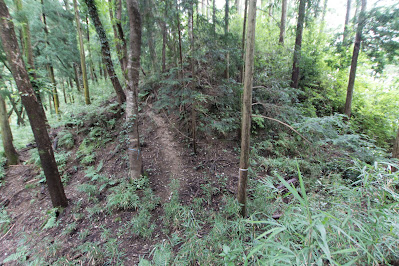





































































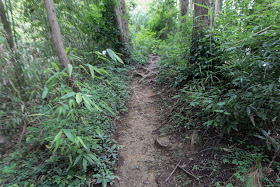





































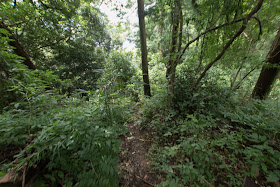










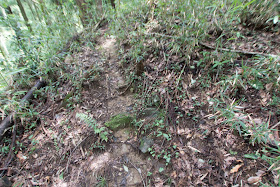



























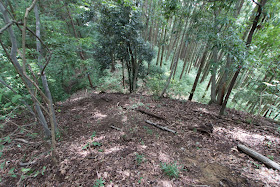












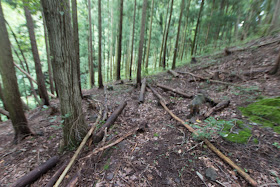










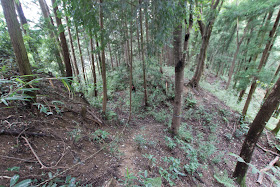










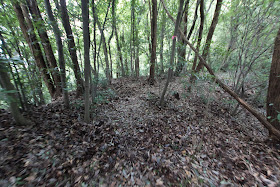
























No comments:
Post a Comment